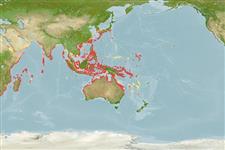Common names from other countries
>
Blenniiformes (Blennies) >
Blenniidae (Combtooth blennies) > Blenniinae
Etymology: Petroscirtes: Latin, petra, -ae = stone + Greek, skirteo = to jump.
More on author: Valenciennes.
Environment: milieu / climate zone / depth range / distribution range
Ecologie
marien; brak water rifbewoner; diepte 1 - 15 m, usually ? - 10 m (Ref. 48636). Tropical; 22°C - 28°C; 30°N - 30°S
Indo-West Pacific: East Africa to Papua New Guinea, north to southern Japan, south to New Caledonia.
Grootte / Gewicht / Leeftijd
Maturity: Lm ? range ? - ? cm
Max length : 11.0 cm SL mannelijk / geslacht onbekend; (Ref. 1602)
Korte beschrijving
Determinatiesleutels | Morfologie | Morfometrie
Dorsale stekels (totaal) : 10 - 11; Dorsale zachte stralen (totaal) : 17 - 21; Anale stekels: 2; Anale zachte stralen: 17 - 21. Dark, broad stripe from snout through eye to caudal fin; stripe may be broken into segments (Ref. 4404). Highly variable in color and mimics Meiacanthus species (Ref. 48636).
Adults inhabit coastal reefs and estuaries to depths of about 10 m (Ref. 48636). May also be found up to 15 m depth in coastal and lagoon reefs in sandy and weedy areas among clumps of Sargassum or other seaweeds. They also take shelter and nests inside small-necked bottles and abandoned worm tubes or shells (Ref. 90102). They feed on small crustaceans, diatoms, and perhaps other plant material associated with such clumps. They use their fangs defensively and will not hesitate to bite if handled, thus, species of this genus are avoided by predators (Ref. 205). Oviparous. Males uses shells but also ring-top cans for nesting (Ref. 48636). Eggs are demersal and adhesive (Ref. 205), and are attached to the substrate via a filamentous, adhesive pad or pedestal (Ref. 94114). Larvae are planktonic, often found in shallow, coastal waters (Ref. 94114). Mimic of Meiacanthus grammistes, which like all species of that genus possesses a pair of large grooved fangs in the lower jaw with associated venom glands. These bites are used defensively and Papuan variety is also a possible mimic of Meiacanthus vittatus (Ref. 90102).
Levenscyclus en paargedrag
Maturities | Voortplanting | Spawnings | Egg(s) | Fecundities | Larven
Oviparous, distinct pairing (Ref. 205).
Myers, R.F., 1991. Micronesian reef fishes. Second Ed. Coral Graphics, Barrigada, Guam. 298 p. (Ref. 1602)
Status op de Rode Lijst van het IUCN (Ref. 130435)
CITES (Ref. 128078)
Not Evaluated
Gevaar voor de mens
Traumatogenic (Ref. 1602)
Gebruik door de mens
Visserij: commercieel; Aquarium: Commercieel
Tools
Speciale rapporten
Download XML
Internetbronnen
Estimates based on models
Preferred temperature (Ref.
115969): 25 - 29.3, mean 28.5 (based on 2854 cells).
Fylogenetische diversiteitsindex (Ref.
82804): PD
50 = 0.5005 [Uniqueness, from 0.5 = low to 2.0 = high].
Bayesian length-weight: a=0.00562 (0.00258 - 0.01228), b=3.06 (2.87 - 3.25), in cm Total Length, based on LWR estimates for this (Sub)family-body shape (Ref.
93245).
Trofisch niveau (Ref.
69278): 2.1 ±0.2 se; based on diet studies.
Weerstandsvermogen (Ref.
120179): Hoog, minimale populatieverdubbelingstijd minder dan 15 maanden (Preliminary K or Fecundity.).
Fishing Vulnerability (Ref.
59153): Low vulnerability (10 of 100).
